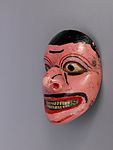Mask
About this object
History of use
Worn during curing ritual of the Sanni Yakuma ceremony, part of the Tovil series of dramas performed by Sinhalese ritual specialists and dancers. The Sanni Yakuma is intended to combat diseases and afflictions caused by the Sanni group of demons. These consist of 18 or more apparitions of the chief demon, Maha-kola-sanni. The officiating healer honours Buddha, then appeases the demons with offerings, dancing, and chanting. This mask possibly represents Vedda Sanni, said to indicate the bubonic plague.
Cultural context
exorcism
Physical description
Human face possibly representing Vedda Sanniya (the bubonic plague). The face is painted pink overall with black hair and a moustache, red lips, and an orange line on the chin. The mask has a short convex nose, a wide mouth, tear-drop shaped eyes with eye holes beneath them and yellow-white eyeballs and teeth. The eyes, nose, mouth and nostrils are enhanced with red and black lines. The reverse of the mask is painted black, and a label on the reverse reads "(Possibly) Vedda Sanni: bubonic plague. 30". Plant fibre ? string is secured through holes on either side of the mask.
Categories
Materials
